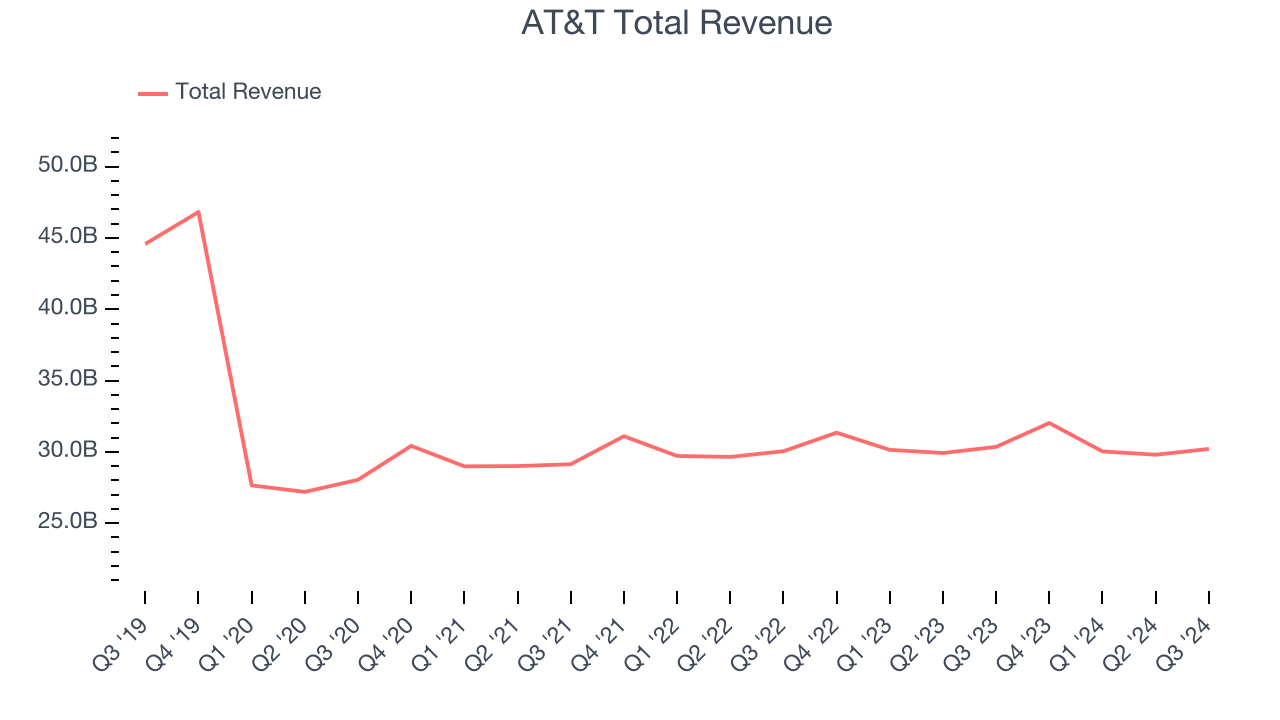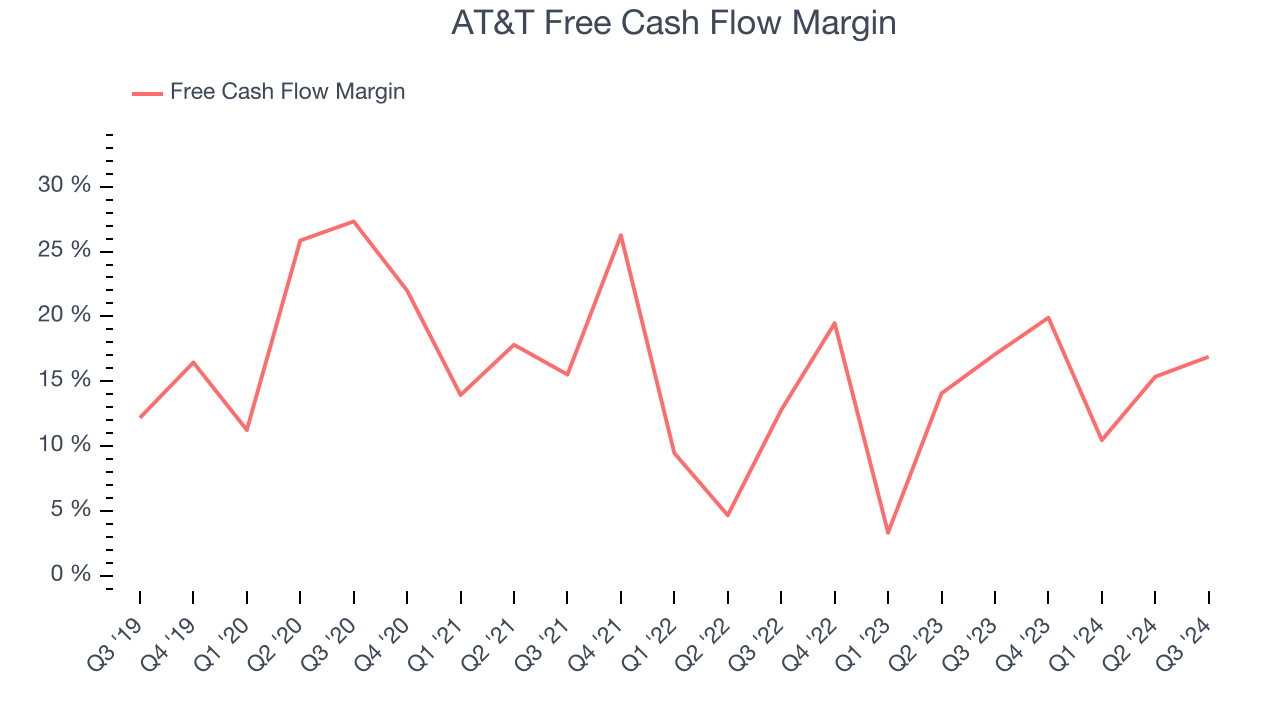
Telecommunications conglomerate AT&T (NYSE:T) met Wall Street’s revenue expectations in Q3 CY2024, but sales were flat year on year at $30.2 billion. Its non-GAAP profit of $0.60 per share was 5.1% above analysts’ consensus estimates.
Is now the time to buy AT&T? Find out by accessing our full research report, it’s free.
AT&T (T) Q3 CY2024 Highlights:
- Revenue: $30.2 billion vs analyst estimates of $30.45 billion (in line)
- Adjusted EPS: $0.60 vs analyst estimates of $0.57 (5.1% beat)
- EBITDA: $11.6 billion vs analyst estimates of $11.39 billion (1.8% beat)
- Management reiterated its full-year Adjusted EPS guidance of $2.20 at the midpoint
- EBITDA Margin: 38.4%, up from 36.9% in the same quarter last year
- Free Cash Flow Margin: 16.9%, similar to the same quarter last year
- Market Capitalization: $154.2 billion
Company Overview
Founded by Alexander Graham Bell, AT&T (NYSE:T) is a multinational telecomm conglomerate providing a range of communications and internet services.
Wireless, Cable and Satellite
The massive physical footprints of cell phone towers, fiber in the ground, or satellites in space make it challenging for companies in this industry to adjust to shifting consumer habits. Over the last decade-plus, consumers have ‘cut the cord’ to their landlines and traditional cable subscriptions in favor of wireless communications and streaming video. These trends do mean that more households need cell phone plans and high-speed internet. Companies that successfully serve customers can enjoy high retention rates and pricing power since the options for mobile and internet connectivity in any geography are usually limited.
Sales Growth
Examining a company’s long-term performance can provide clues about its business quality. Any business can put up a good quarter or two, but the best consistently grow over the long haul. AT&T’s demand was weak over the last five years as its sales fell by 7.7% annually, in large part due to a major divestiture.

Long-term growth is the most important, but within consumer discretionary, product cycles are short and revenue can be hit-driven due to rapidly changing trends and consumer preferences. AT&T’s revenue over the last two years was flat, sugggesting its demand was weak but stabilized after its initial drop in sales.
AT&T also breaks out the revenue for its most important segment, Mobility. Over the last two years, AT&T’s Mobility revenue (wireless plans) averaged 1.9% year-on-year growth. This segment has outperformed its total sales during the same period, lifting the company’s performance.
This quarter, AT&T’s $30.2 billion of revenue was flat year on year and in line with Wall Street’s estimates.
Looking ahead, sell-side analysts expect revenue to grow 1.6% over the next 12 months, similar to its two-year rate. This projection is underwhelming and indicates the market thinks its newer products and services will not accelerate its top-line performance yet.
When a company has more cash than it knows what to do with, buying back its own shares can make a lot of sense–as long as the price is right. Luckily, we’ve found one, a low-priced stock that is gushing free cash flow AND buying back shares. Click here to claim your Special Free Report on a fallen angel growth story that is already recovering from a setback.
Cash Is King
Free cash flow isn't a prominently featured metric in company financials and earnings releases, but we think it's telling because it accounts for all operating and capital expenses, making it tough to manipulate. Cash is king.
AT&T has shown impressive cash profitability, giving it the option to reinvest or return capital to investors. The company’s free cash flow margin averaged 14.6% over the last two years, better than the broader consumer discretionary sector. The divergence from its underwhelming operating margin stems from the add-back of non-cash charges like depreciation and stock-based compensation. GAAP operating profit expenses these line items, but free cash flow does not.

AT&T’s free cash flow clocked in at $5.1 billion in Q3, equivalent to a 16.9% margin. This cash profitability was in line with the comparable period last year and above its two-year average.
Over the next year, analysts’ consensus estimates show they’re expecting AT&T’s free cash flow margin of 15.7% for the last 12 months to remain the same.
Key Takeaways from AT&T’s Q3 Results
It was encouraging to see AT&T slightly top analysts’ EPS expectations this quarter. On the other hand, its Mobility revenue unfortunately missed and its revenue fell short of Wall Street’s estimates. That the company reiterated full year EPS guidance was comforting. Overall, this was a decent quarter. The stock traded up 2.8% to $22.10 immediately following the results.
Big picture, is AT&T a buy here and now?We think that the latest quarter is only one piece of the longer-term business quality puzzle. Quality, when combined with valuation, can help determine if the stock is a buy.We cover that in our actionable full research report which you can read here, it’s free.













